Johnson Doctrine
[1] During Johnson's presidency, the U.S. again began interfering in the internal affairs of sovereign nations, particularly Latin America (reversing the previous Good Neighbor policy of the decades prior).
[2] Such anti-communist sentiments were made evident through statements such as the Truman Doctrine, which declared that the United States would provide assistance to nations threatened by authoritarianism.
[5] However, the more recent interventions in Latin America prior to the implementation of the Johnson Doctrine were more covert such as the Bay of Pigs Invasion.
[8] As a result the United States intervened in several countries, including the Dominican Republic, in an effort to prevent the spread of communism.
This organization, along with the Inter-American Treaty of Reciprocal Assistance of 1947, meant that the United States could still intervene but needed clear justification to do so.
In his May 2 address, Johnson specifically stated that the American countries would not permit the establishment of another "communist government" in the Western Hemisphere.
[12] During the time of 1964 to 1965 when Dr. Larson and Mr. Dallin published their findings they came upon the key assumption in this doctrine is that due to an imbalance in strategic weapons favoring the United States, the Soviet Union had since redressed the balance in this category for strategic weapons namely in ICBMs during this time as well as showing negative views on arms limitations and arms control agreements between the U.S. and the Soviets.
[13] In securing the Middle East, Eisenhower applied his doctrine in 1957 and 1958 by sending money to the Kingdom of Jordan, encouraging Syrians to hold military operations against it, and deploy U.S. troops to Lebanon to halt any radical changes.
In 1965 Johnson sent over 20,000 troops to the Dominican Republic under the idea that the United States and other nations would not allow a communist government to foster in the Western Hemisphere.
In Latin America, the U.S. intervened to prevent perceived threats from leftist forces; some confirmed interventions included Operation Condor in the 1970s, support of the Contras in Nicaragua, and the invasion of Grenada in 1983.
Furthermore, the U.S. maintains a military presence in countries around the world[15] in addition to providing foreign aid to support American interests.


